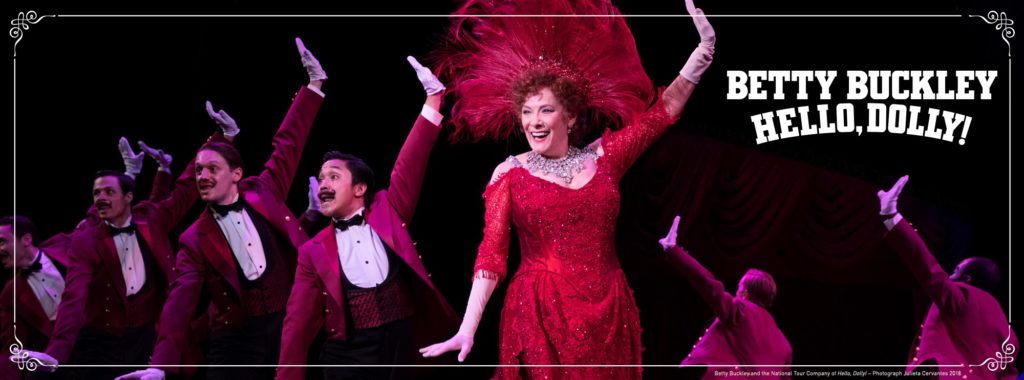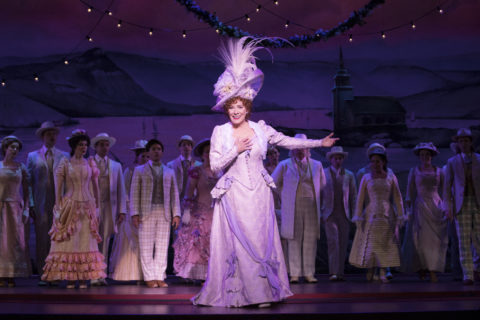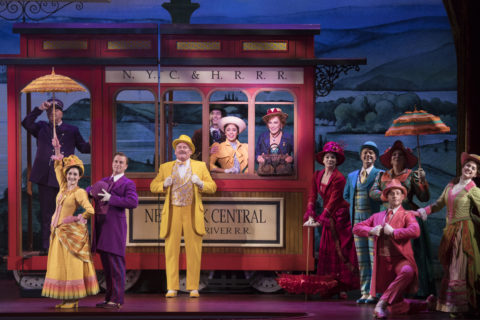
“Before the Parade Passes By,” the full-ensemble song and dance extravaganza that closes Act I of “Hello Dolly” finds long-widowed matchmaker Dolly Levi Gallagher, resolving to move beyond her beloved late husband and march forward, set on capturing the affections of wealthy Horace Vandergelder.
Its more than ironic that the banners festooning this particular parade—the show is set at the turn of 20th century— include one that calls for women’s suffrage.
When the original Broadway run of composer Jerry Herman and director Gower Champion’s hummable humdinger opened way back in 1964, the musical was already a nostalgia-fest. In today’s world, despite its spate of showstopping musical numbers and an eye-popping, color-drenched production, the national tour of the 2017 Broadway revival—now running at the Golden Gate Theater—feels downright antiquated.
“Dolly” was never intended to be deep. And, when it opened two months after the assasination of JFK, it probably felt like a much-needed breath of fresh-air. But for all its would-be winsome, innocent Americana, the show’s take on women as helpmates and housekeepers for husbands on whom they depend for their money and social status, is no longer a romantic notion. The parade has passed “Dolly” by.

Photo: Julieta Cervantes
But ever since the late Carol Channing gave the title role her pop-eyed, singing-through-the-teeth signature in that first Broadway production, “Hello Dolly” has come to function as more than a book musical, its a fancy-dress showcase for leading ladies. The frivolous, dizzy plot (Four different couples spin their way towards the aisle) becomes a flexible setting for whatever jewel is mounted at its center. Ethel Merman, Pearl Bailey, Ginger Rogers and Phyllis Diller have all had their turns in a role that bends to fit a variety of personae. Audiences love a star-turn, and “Dolly” flatters its leads with a gig that gives them entrance after entrance, costume after costume, applause line after applause line. Even so, after a Broadway absence of 22 years, would the undeniably dusty “Dolly” ever have made its way back without Bette Midler as its lead? Its easy to imagine Midler’s hambone magnetism and well-known liberal and feminist cred superceding the material.
On the current tour, Betty Buckley steps into the role. While beloved by music theater and cabaret cognoscenti, Buckley is not instantly recognizable as a famous personality to general audiences. So, by necessity, she approaches the role as the fine actress she is, revealing a limpid vulnerability beneath Dolly’s public confidence without ever losing command of the procedings. Her singing has a burred warmth that brings a dimension of genuine feeling to the otherwise emotionally flimsy scenario.
Still, as directed by Jerry Zaks, the production—like those before it—is constantly nudging the audience to adore not the character of Dolly, but the celebrity performer in the role. On opening night, the Golden Gate crowd played along, simulating idol worship for a non-idol in much the way the audiences at nearly every touring musical give a standing ovation at the curtain call. The hollowness of these obligatory rituals is pretty much the opposite of what theater artists should strive for.
On the other hand, one of theater’s holy grails—an honest rush of audience adrenaline—is handily achieved in the farcical restaurant scene that makes up the bulk of Act II, ending with a chorus line of formal waiters clacking silver cloches, twirling champagne coolers, and cleverly cakewalking across the stage in a gorgeously disciplined flurry of choreography which Warren Carlyle has closely modeled after Gower Champion’s original dances.

Photo Credit: Julieta Cervantes
Likewise, there’s genuine old-fashioned fun to be found in stage veteran Lewis J. Stadlen’s comic turn as Vandergelder. His clever vaudevillian patter song “Penny In My Pocket,” which opens Act II, was cut from earlier productions and restored in 2017—an excellent decision. And Nic Rouleau, as Vandergelder’s virginal young business associate, Cornelius, offers a winning, grinning mix of naiveté and enthusiasm—not to mention a standout tenor voice.
Santo Loquasto’s set design, particularly that tony restaurant, Harmonia Gardens, with its dramatic staircase and plush-curtained booths; and the enormous Currier & Ives-style illustrations that indicate location shifts between Yonkers and New York City, convey an elegant period charm. But his costumes—bustled dresses, tailored suits and top hats, feathered headpieces—burn the eyes with near-incandescent yellows, purples, reds and blues, as if Pikachu, Barney, Elmo and the Smurfs had been sacrificed for their pelts.
Yet this wardrobe is hardly the most glaring of issues when considering “Hello Dolly” in 2019. Even gussied up in frolic and frippery, the show’s core storyline is doomed to sexist obsolescence. It may be time for this musical to settle into place as a celebrated museum piece rather than a part of the popular repertoire. The title song’s brassy chorus insists that “Dolly’ll never go away.” Fair enough. But its time she be kept at an appropriate distance.
Originally published in the Bay Area Reporter
